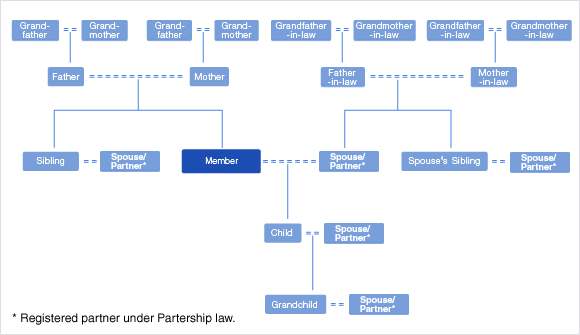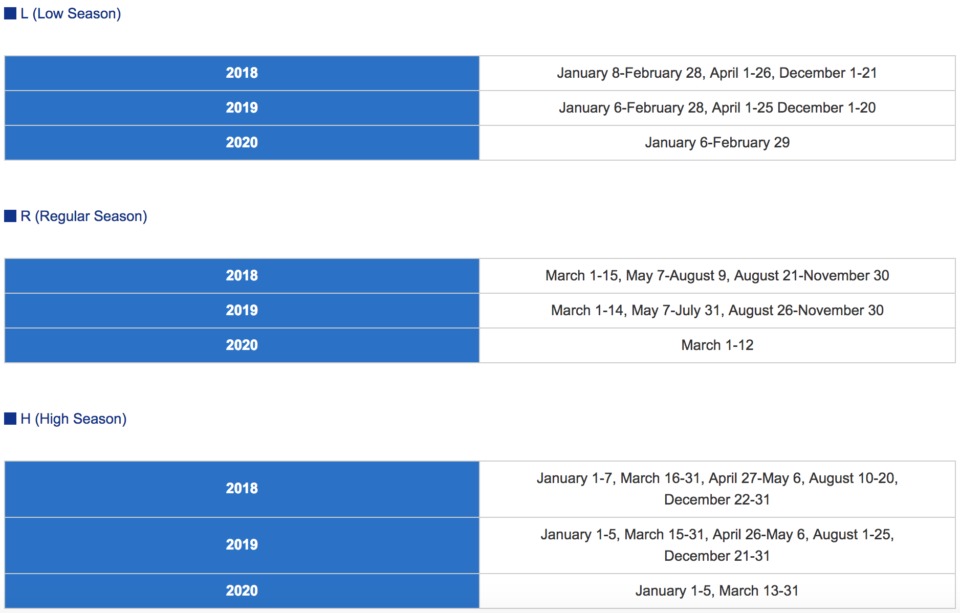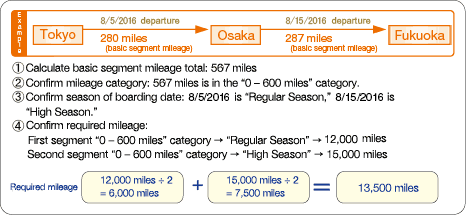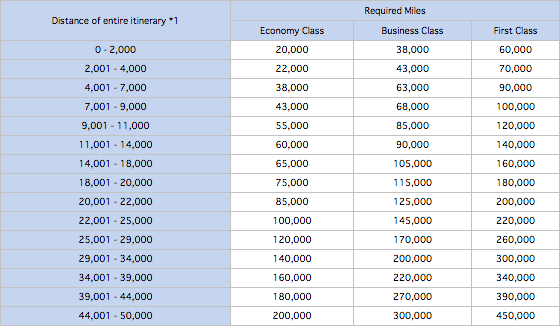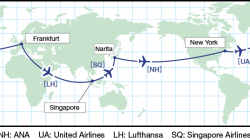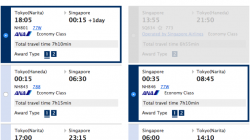ANA Mileage Club miles can be used for award travel on ANA and on 34 international partners. The number of miles and the fees required for an award ticket will depend on which airline you choose to fly. This guide will walk you through the process of finding and booking an award.
Who Can Travel
Before we even get started, know that you can only redeem your ANA miles for travel by yourself or by family members within two generations. This list includes:
- Your grandparents, parents, and siblings
- Your children, grandchildren, and their spouses or partners
- The parents and grandparents of your spouse or partner
All travelers are required to register before booking an award — except you, because they already have your profile information. Up to 10 of your family members may be registered. Deleting or changing profile information will cost 5,000 miles each.
Compare Award Prices
In many cases travel on flights operated by ANA will require fewer miles than United Airlines, especially in business or first class. But ANA actually has four different award charts depending on the airline and your destination. Some other programs like Aeroplan may charge even fewer miles or have more flexible rules.
For example, ANA does not permit using your miles for last-minute travel within 96 hours of departure and requires all travelers to register before booking a ticket. While it makes it easier to search for Singapore Airlines award space online (United blocks it) it nevertheless prohibits award travel in first or business class on Singapore Airlines on flights operated by the Boeing 777-300ER or Airbus A380-800.
Compare award prices from ANA Mileage Club and other programs.
There are four different award charts used by ANA, of which two have seasonal variations, two are zone-based, and two are distance-based. It’s complex enough that I recommend you read my description of each even if you get a rough idea of the price using the Award Maximizer tool above.
International Award Travel on Partner Airlines
ANA allows award travel on Star Alliance members and on a variety of non-alliance partners. Star Alliance awards can include multiple airlines in a single itinerary. However, only one airline is permitted when traveling on a non-alliance partner (no connections to flights operated by other airlines).
Pricing is generally very simple. All awards must be booked for round-trip travel, and the award chart does not have any seasonal variation. If you are referencing prices provided by the Award Maximizer tool, remember that they are presented as one-way equivalents; multiple by two to obtain the round-trip price.
Pricing does get a little complicated if your trip involves travel to/from Japan, which has two regions: Zone 1-A and Zone 1-B. Zone 1-A is cheaper and comes with additional restrictions. If those restrictions are not met, then Zone 1-B pricing will apply.
International Award Travel on ANA
Calculating the cost of an international award on ANA avoids the Zone 1-A/B confusion and may be cheaper than a partner award, but you may only use these awards for travel on ANA and for ANA codeshares operated by Air Japan. These are also listed in the Award Maximizer tool.
There are also seasonal variations that require more effort to interpret. These dates change every year, and the dates for 2018-2020 are copied below.
Japan (Zone 1) to Europe and North America (Zones 6 and 7)
Japan (Zone 1) to Asia (Zones 2, 3, and 4)
Japan (Zone 1) to Hawaii and Oceania (Zones 5 and 10)
There are also two blackout dates–January 1 and 2–for flights from other countries (not Japan) to Hawaii. That means you can’t book any international flight award on January 1 or 2 to/from Hawaii unless you are flight to/from Japan. Other countries like the US are blacklisted on those dates.
Notice that the seasonal dates are published for just three broad regions: (1) Japan to North America, (2) Japan to the rest of Asia, and (3) Japan to Hawaii or Australia. However, ANA also publishes awards for other combinations, like between Europe and Australia. My assumption is that you will be connecting through Japan and so the most restrictive season applies. For example, let’s say that May 31 is the low season between Australia and Japan, but it is the regular season between Europe and Japan. The regular season pricing will apply if you try to book it as a single award.
Remember that all international awards are for round-trip travel. If your dates involve travel during two different seasons on the outbound and return journeys, then determine the price of a round-trip award in each season and average these numbers to determine the final price. ANA provides the example of travel between Tokyo and Los Angeles.
The outbound journey is in the low season (40,000 miles), and the return journey is in the regular season (50,000 miles), for a final price is 45,000 miles. A similar rule of averaging prices will apply if you travel in one cabin class during the outbound journey and a different cabin class during the return journey.
Domestic Award Travel on ANA
I think fewer people who read this post will be looking to book domestic awards on ANA, which is why I’ve put this section last. This is the only instance when ANA Mileage Club permits one-way awards, which are half the price of a round-trip award. However, round-trip pricing is still relevant because ANA looks at the distance of the entire journey. I’ve copied the award chart below, along with the dates of each season. These are not available in the Award Maximizer tool at this time. (The award chart is older but still accurate. I’ve kept it as the new chart is enormous and difficult to read. The seasonality is more recent.)
How should you read this? It’s not as easy as it looks. ANA is always operating with a round-trip mentality even if it says a one-way award is permitted. To price a one-way award, calculate the distance as if it were a round-trip itinerary. Then look at the award chart and select the one-way price.
Example 1: Nagasaki (NGS) to Osaka (ITM) is a journey of 343 miles. This is well within the 0-600 band as a one-way journey, but it would fall within the 601-1,200 band if booked as a round-trip. The ANA search engine quotes a price of 7,500 award miles during the regular season even when traveling one-way, which implies it is looking at the 601-1,200 band.
When combining two segments to create a round-trip or open jaw, you don’t need to double the distance. Instead calculate the total distance of the itinerary.
Example 2: Osaka (ITM) to Haneda (HND) is a journey of 251 miles, and Haneda (HND) to Nagasaki (NGS) is 593 miles. Together they form an open jaw with a total distance of 845 miles that will cost 15,000 award miles during the regular season because it falls within the 601-1,200 band.
What if your flights occur in different seasons? ANA’s example of a trip from Tokyo to Osaka during the regular season and returning from Osaka to Fukuoka in the high season. It considers the total distance of the trip and then averages the cost of this trip in each season.
However, be aware that some itineraries might actually save you money when booked as separate one-way tickets. Go back to Example 2, which involved travel between Osaka, Haneda, and Nagasaki.
Example 3: HND-NGS would cost 7,500 award miles. We already established in Example 1 that even when traveling one-way, you need to imagine the distance of a round-trip journey and then look up the one-way price. But booking ITM-HND by itself would cost 6,000 award miles because a trip of 251 miles will fall within the 0-600 band even when you double it. The total cost for two awards in the regular season is 13,500 miles.
In other words, the two awards booked separately cost 1,500 miles less than the 15,000 miles I was quoted for an open jaw booked as a single award (10% savings). The lesson is to be careful when the combined distance of a round-trip domestic itinerary bumps into a higher category.
Round-the-World Awards
ANA still offers a distance-based award chart for international travel, but it has been repurposed for round-the-world awards. Calculate the total distance of each segment using a tool such as GCMap.com and then refer to the chart to determine the cost of your award in each cabin class. These are not available in the Award Maximizer tool at this time.
Round-the-world awards are actually cheaper than partner awards in some circumstances. However, the caveat is that you must travel in one direction, either east or west. Also, your total itinerary must be longer than 10 days (board the last international flight to your country of departure at least 10 days after you boarded the first international flight). Other than these points they are exempt from the usual ANA routing rules that concern stopovers and connection points.
Estimate Taxes, Fees, and Surcharges
Because the same award space is generally available to all partners, you should also consider the possible fees and surcharges that will apply before you redeem your miles. If you have miles with both United and ANA, for example, they probably have different award prices for the same ticket. But they will also have different fees, and ANA’s fees are likely to be higher. On the other hand, each program is limited by different transfer partners. Depending on what you have to work with you may not have much choice.
These are reasons why I recommend that you familiarize yourself for these fees before you begin searching for award availability, perhaps even before you begin to accumulate miles in the first place.
Learn more about taxes, fees, and surcharges when booking through:
- ANA Mileage Club
- United MileagePlus
- Air Canada Aeroplan (coming soon)
- Singapore Airlines KrisFlyer (coming soon)
Review the Award Routing Rules
One last thing before you start searching: make sure you are familiar with the ANA Mileage Club routing rules. They are similar to the United MileagePlus routing rules in many cases, with some additional limits to the number and location of stopovers and connections. You shouldn’t have a problem in most cases, but some people get in over their head. That’s where you need to know if your routing is actually legal and the site is creating an error or if you’re the one who is mistaken.
You may get lucky and find results on your first try, searching from your origin to your destination. In many cases, however, it’s easier to find the flights you want if you break up your search and look one leg at a time. For example, if you want to travel from the U.S. to Europe, create a list of all the gateway airports in each region. (Gateway airports are international departure and arrival points. They may be big hubs like New York or smaller cities like Seattle.)
The logic here is that when you submit a search the airline’s computers will consider all possible connecting points and then look to see if there is award space on all segments of your journey. But computers take shortcuts and sometimes miss things. If you do the work yourself you will be more certain that you have exhausted every option. If you live in Seattle you might look for flights to San Francisco, Los Angeles, Houston, and even Newark. Then from each of those cities you might look for flights to Zurich, Frankfurt, Brussels, and so on. However, start with the longest flights in the middle. The short connections on either end are easier to find.
As you find award availability, you can piece together an entire trip — always staying within the award routing rules. You can visit an airline’s website or OpenFlights.org to get more information about which airlines serve which cities.
Learn more about the ANA Mileage Club routing rules.
Find Award Availability
There are three primary locations where you might search for award space on United Airlines and its partners: ANA.co.jp, United.com, and Aeroplan.com. These are all free to use.
Most awards can be ticketed online using the ANA website. If you cannot ticket online for a technical reason, then you can call the ANA Service Center and ask them to waive the telephone reservation fee. The U.S. number is 1-800-235-9262 and is available 24/7.
Find Award Space Using ANA
Because you’ll actually book your award with ANA, I recommend using this website to search, too. However, it isn’t the most convenient to use. (I’ll grant it is easier than before. That doesn’t mean it has managed to become easier than United or Aeroplan.) One of the biggest limitations is that you cannot search for most flights departing within 96 hours of departure — but this is irrelevant because you can’t book close-in awards anyway.
One of the key benefits of the ANA website is that you can search for every Star Alliance partner, including Singapore Airlines (which United excludes).
ANA has some other non-alliance partners, including Etihad, Virgin Atlantic, and Jet Airways. You cannot use ANA to search for these carriers’ award space online with one exception: Garuda Indonesia can be booked online. Instead, call in and ANA will waive the telephone booking fee.
In addition, know that ANA has limitations on how you can mix and match carriers. Itineraries operated exclusively by ANA are the cheapest. A separate partner award chart applies when you travel on Star Alliance members, which you can mix with each other and with ANA. The same partner award chart applies to partners like Garuda Indonesia, but non-alliance partners cannot be mixed with other carriers.
Learn more about how to search for award space on the ANA website.
Find Award Space Using Aeroplan
Aeroplan (an independent loyalty program affiliated with Air Canada) offers one of the more comprehensive and user-friendly tools for finding award space on other Star Alliance partners. You might also find that some awards are more attractive when booked with Aeroplan instead of ANA or United.
Learn more about how to search for award space on the Aeroplan website.
Find Award Space Using United Airlines
Award space for nearly all Star Alliance carriers and most non-alliance partners should be visible on the United Airlines website. Although United excludes Singapore Airlines, I still recommend it because the site is generally fast and user-friendly. It’s easy to view two months’ of award availability at once with color-coded indicators.
ANA and United share a few non-alliance partners, as well. These include Air Dolomiti, Eurowings, and Hawaiian Airlines. Because ANA doesn’t display them, search for these on the United website and then call ANA to book an international partner award. (Caution: United may suggest itineraries that mix these partners with other Star Alliance members, but ANA does not permit this.)
Learn more about how to search for award space on the United website.
Other Airline Partners
Etihad award space is available on its own website; look for “Guest Seat” availability to find award space made available to partners.
Award space for Virgin Atlantic and Garuda Indonesia can both be found on the Delta Air Lines website. Like the United site, you might find itineraries that include segments on other airlines, including airlines that are partners with Delta and not ANA. Regardless of who those other partners are, remember that ANA limits you to one airline when booking award travel on non-alliance partners.
Finally, I’m not aware that Philippines Airlines makes it possible to search for award space online. But I’ve read several reports that it is plentiful and easy to get, so you shouldn’t have much trouble if you just call in and try your luck by phone.

